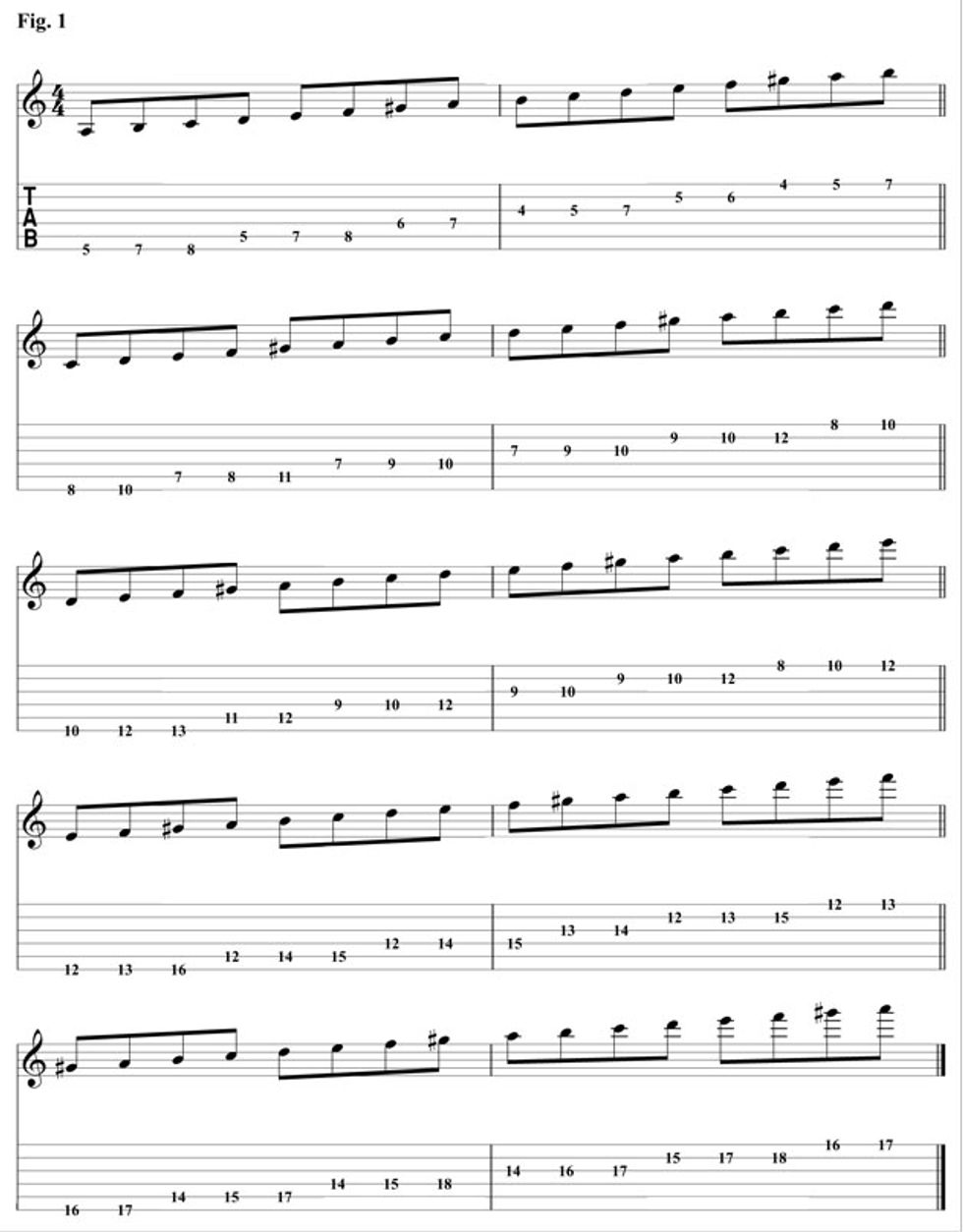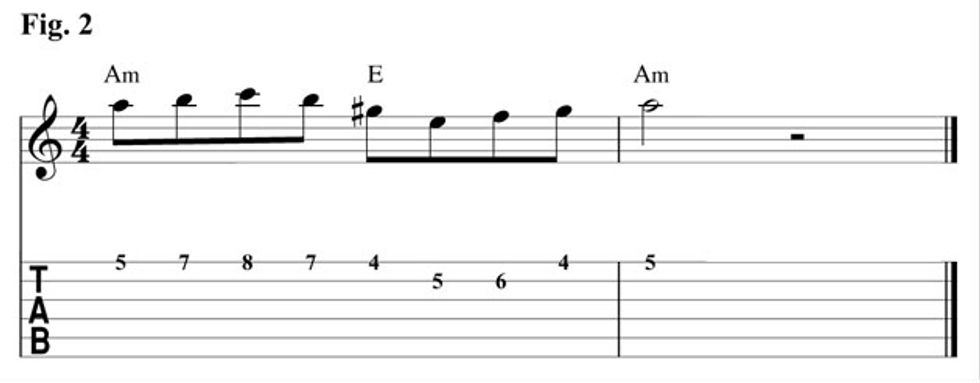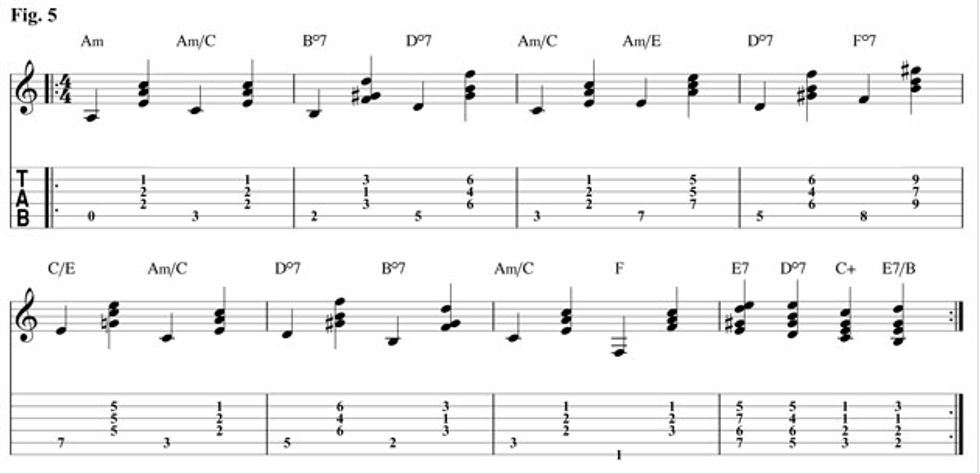Chops: Intermediate
Theory: Intermediate
Lesson Overview:
• Discover new and unusual sounds within the harmonic minor scale.
• Learn how to apply modal tonalities to your own songs.
• Understand more about augmented and diminished harmony.
Click here to download a printable PDF of this lesson's notation.
The harmonic minor scale has been a topic of conversation among guitar players for many years. Most notably the discussion became a primary focus for many shred players after they heard Yngwie Malmsteen’s stunning debut, Rising Force, which features solos and riffs drawn from the harmonic minor scale on nearly every track. But the use of the harmonic minor reaches far beyond the realm of the shred guitarist. The harmonic minor sound can be found in flamenco, East European, Middle Eastern, and Indian music, as well as mainstream rock, jazz, and even bluegrass.
In this lesson, we’ll quickly review the fundamentals of this scale—including all the patterns you’re likely to ever need—and discuss its most common uses.
But even more interesting and less commonly discussed are the modal sounds hidden within the scale. I’ll identify and demonstrate these sounds and provide you with a few of the many chordal possibilities the harmonic minor scale offers. These should help lead you to some fresh, exciting, and exotic territories.
Fig. 1 contains five different patterns for the harmonic minor scale, shown here in the key of A minor. As you might have learned in dealing with the modes of the major scale, starting on a different note—one other than the root—gives you all the different modal flavors of the scale.
Okay, let’s get to some practical applications. Fig. 2 is probably the simplest and most common use of the harmonic minor scale you will hear. But here’s the trick: It’s not only the melody that is fueling the harmonic minor sound, but the chord progression as well. You see, the only difference between the harmonic minor scale and the natural minor—or Aeolian—is the seventh note. That means that A natural minor has a G natural in it, and A harmonic minor has a G#. This seemingly small change radically alters the overall harmony, once you start building chords.
The next two examples demonstrate the difference between chords built from the natural minor scale and chords built from the harmonic minor scale. Fig. 3 shows the A natural minor scale (Aeolian) harmonized to get these common chords: Am, Bm7b5, C, Dm, Em, F, and G.
On the other hand, when you harmonize the A harmonic minor (Fig. 4), you get: Am, Bdim, Caug, Dm, E, F, and G#dim. Check it out: The B is now fully diminished, the C major has become C augmented (this is very unusual), the E minor has become E major, and the G major has become G#dim, another radical change.
It is also worth noting that you get two additional chords from the diminished chords: The notes in Bdim and Gdim are the same as the notes in Fdim and Ddim. How cool is that!
And there’s more: You can think of Caug as also being Eaug or G#aug. Trust me, this becomes a very cool concept when composing chord progressions. Oddly enough, very few contemporary, non-classical composers have taken advantage of this. The A section of “East St. Louis Toodle-Oo” by Duke Ellington and James “Bubber” Miley—later recorded by Steely Dan on Pretzel Logic—is one of the few tunes I know of that exploits the full potential of the harmonic minor sound.
Fig. 5 provides an approximation of this A section. Note the clever chord inversions—Am/C, Am/E, E7/B, and the diminished chords.
The last group of examples are various short harmonic minor modal vamps—most of them arpeggiated—to get you used to these new, unusual sounds. I’ve written out the various chord changes and arpeggios you’ll hear in the audio examples. After establishing the vamp for a few measures, I add melodies in various styles that will allow you to hear a few of the soloing possibilities these progressions suggest.
All the notes I play in these solos come directly from the harmonic minor scale, but that really isn’t the point. Instead, the point is the chord progressions all come from the harmonic minor scale and that allows us to play very simple solos, yet still evoke more exotic sounds and moods because of the nature of the chord progressions themselves.
The vamp in Fig. 6 provides a dark and tense atmosphere—perfect for an intro to a metal tune. Generally, here I think of B Locrian with a natural 6.
We juxtapose augmented and major triads for Fig. 7. It imparts the feeling of an oxymoronic, but peaceful uneasiness. Very psychedelic.
The funky three-chord jam in Fig. 8 takes Zappa’s “Carlos Santana Secret Chord Progression” a little more outside.
E Phrygian dominant is probably the most commonly used mode of the harmonic minor scale. Fig. 9 conjures up images of southern Spain and flamenco dancers.
This haunting harmonic atmosphere (Fig. 10) is ethereal and yearning. It never wants to resolve to a specific chord, and though it’s often used in new age music, you can also find examples in instrumental shred.
The Super Locrian scale is aggressive and dissonant. When working through the vamp in Fig. 11, think of Les Claypool and early Primus.
Though some of these progressions might sound a bit strange at first, give them a chance to grow on you. Perhaps you rarely hear them because they sound strange. Or maybe they sound strange because you rarely hear them. Either way they are worthy of your time, study, and curiosity. If one of the jobs of musicians is to make “new” music, why not really do your best to make something new? I’m not saying you should play weird or strange just for the sake of doing it, yet there’s much to be gained by experimenting. And who says you have to subject the world to your experiments? Practice these in the privacy of your home. You can decide later if you want to unleash them on the world at large. Play weird! Make mistakes. Who knows? You might learn something.

































